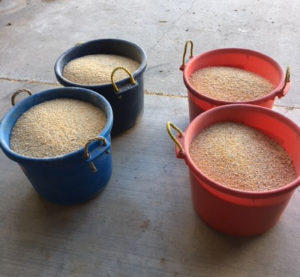
Increasing levels of dietary fumonisin do not adversely affect feedlot cattle performance, according to a Texas A&M AgriLife Research scientist in Amarillo.
After a tumultuous 2017 corn season resulting in grain price discounts due to fumonisin, Dr. Jenny Jennings, AgriLife Research beef nutritionist in Amarillo, conducted a controlled beef cattle feeding study to determine the dangers of the mycotoxin in feed corn.
Fumonisin is primarily produced by two species of Fusarium fungi and can be toxic to livestock and humans at high levels. The U.S. Food and Drug Administration set guidance levels in 2001 for the amounts corn and feed may contain.
Jennings said a lack of scientific literature on ruminant exposure to levels between 25 parts per million and 120 parts per million led FDA to choose a “conservative” limit of 60 parts per million as the guideline for corn fed to cattle in a feedlot. The guideline is corn with 60 parts per million fumonisin levels cannot make up more than 50 percent of their ration.
Fumonisin contamination in corn can be found around the world, said Dr. Jourdan Bell, Texas A&M AgriLife Extension Service agronomist in Amarillo. Yearly levels vary due to environmental conditions, hybrid susceptibility and management.

In 2017, fumonisin levels were elevated due to environmental conditions that favored fusarium infestation and fumonisin development in Texas High Plains’ corn, Bell said.
“Last year was an educational year,” Bell said. “It prompted regional research that will benefit both the corn producers and cattle feeders.”
With the majority of the Texas High Plains’ feed corn production going to the cattle feeding industry, Jennings’ study should have wide-reaching effects in both industries, she said. There are approximately 770,000 acres of corn grown in the High Plains and over 2 million cattle on feed in the region.
Bell said there were many unanswered questions about the guidance levels, testing procedures, discounts at the elevator and feeding within the beef industry.
“A local feeder approached me last year and asked if we could answer this question with science,” Jennings said. “I was amazed at how many entities came together and supported the research. Everyone just wanted answers.”
Both Jennings and Bell stressed this study does not change the implications of other livestock feeding regimes.
But Jennings hopes her findings will contribute to updating the guidance levels for beef cattle.
The cattle used for the study were provided by a local feeder, and research funds were provided by AgriLife Research, local beef nutrition entities, ethanol producers, the Texas Cattle Feeders Association and Texas Corn Producers Board.
Jennings fed 49 steers a dry, rolled corn-based finishing diet. The rations were targeted to contain less than 5 parts per million total dietary fumonisin as a control, with other rates of 15, 30, 60 and 90 parts per million. The actual daily levels averaged 8.1 parts per million up to 108.8 parts per million because the corn fed was naturally infested with fumonisin, so levels varied.
The cattle were followed through harvesting and processing, where she monitored marbling score, rib eye, quality and yield grade, and livers were examined for abnormalities.
No difference in performance, carcass or liver characteristics were observed in steers fed dietary levels of fumonisin ranging from 8-108 parts per million for 110 days prior to harvest, Jennings said.
Her results were similar to a study done in 1993 that showed no difference in body weight, average daily gain or dry matter intake among calves fed three treatments of dietary fumonisin for 31 days, followed by 30 days on a control diet, Jennings said.
“The results of our study support the theory of reduced susceptibility of beef cattle to the effects of fumonisin and suggests that this reduced susceptibility may hold true for cattle fed to heavier final weights and for longer feeding periods, such as in a commercial feedlot setting,” Jennings said.
